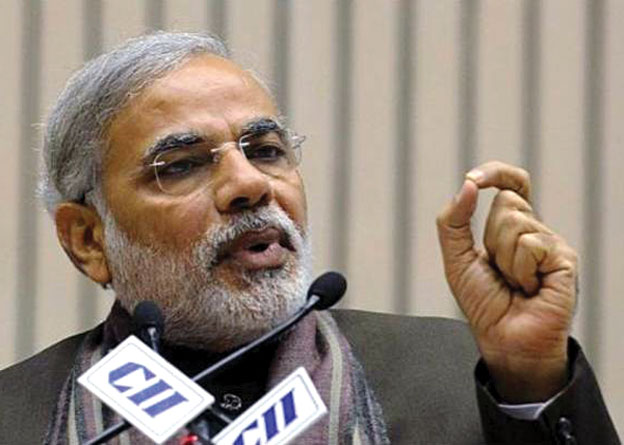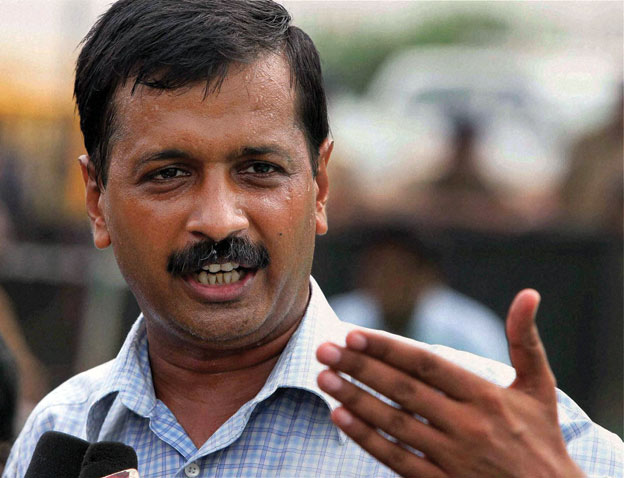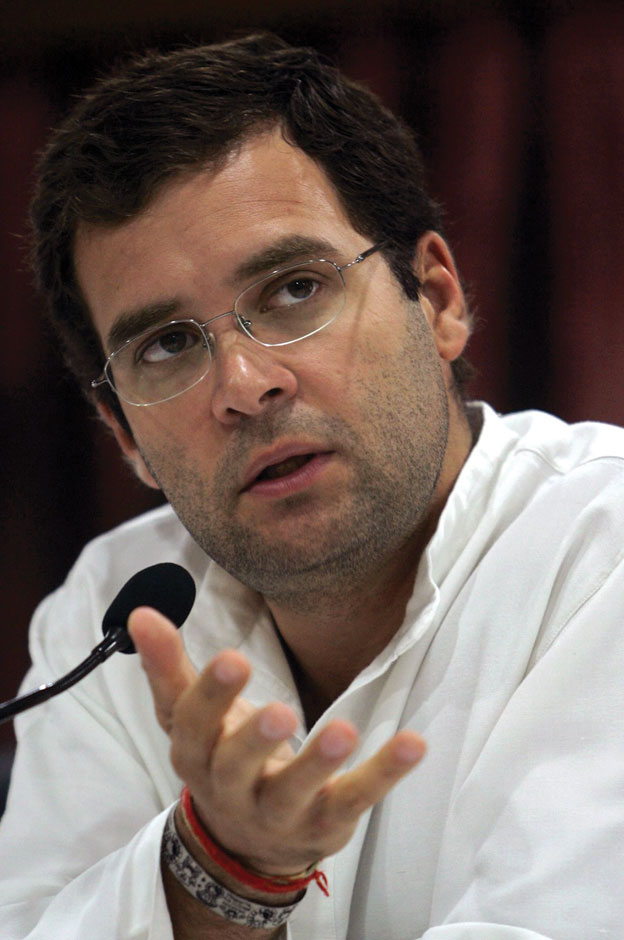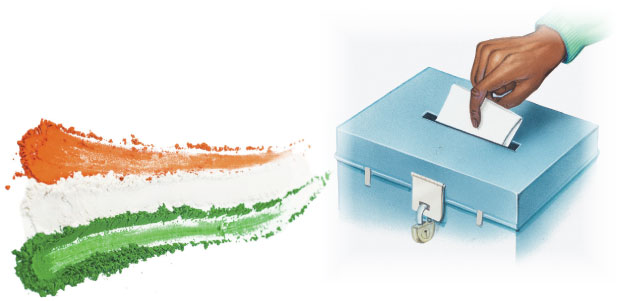According to the Election Commission, that organizes and conducts elections, out of a total population of 1.2 billion, 814 million of registered voters comprising 11,484 non resident Indians (NRIs) and more than a 100 million first time voters (between 18-23 years of age) will get to wield their voting power in an egalitarian fashion in this otherwise unequal part of the world, where the poor lack toilets or safe drinking water.
For any party to stake a claim to government formation, it needs a minimum of 272 seats, a Constitutional requirement, and for the voters, the main options on the political table include:
(a) Congress, a party that is forecast to suffer the worst electoral defeat primarily from anti-incumbency stemming from its record of running a decade long weak, incommunicative, venal and incoherent United Progressive Alliance government;
(b) Bharatiya Janata Party, riding the Narendra Modi (its Prime Ministerial nominee) wave. Gifted with oratorical skills that have enabled him to connect with the masses in the northern and Hindi speaking belt, for the first time after late Prime Minister Indira Gandhi from the Congress party. His constant allusions to salvage national glory, and his track record of Gujarat model signifying development and governance as against the slumping national economy that has attracted the middle classes and corporate India alike, Modi has emerged a favorite among the media and pollsters that harp on a close to 270 seats victory for his party. In this scenario the BJP would gain ample capability to lead the National Democratic Alliance to form the government; and,
(c) A bunch of regional parties and powerbrokers who constantly challenge the above two parties and might ally and perhaps also grudgingly agree to be led by the emerging anti-graft alternative, Aam Admi Party (AAP) that made a stunning debut in Delhi state elections last December.

(Above): BJP Prime Ministerial candidate Narendra Modi.
Astounding as it may sound, these polls are expected to cost no less than $5 billion, obviously fuelled by unaccounted for and black money funding from corporate houses and local businesses who expect some quid-pro-quo post polls, despite the Election Commission prescribing a limit of Rs. 7 million or $116, 350 for each political candidate’s campaign expenditures and Rs. 5.4 million or $90,000 for those contesting in the states of Arunachal Pradesh, Goa and Sikkim, and other Union Territories.
In the fray are about 15,000 candidates from at least 500 political parties and till now the election turnout, as most reports suggest, is as good as 67 per cent, a ten percent jump since 2009.
These figures might be indicative of an enthusiasm among first time voters and the common citizens who choose to engage with democracy and want a change.
Analysis reveals voting behavior to be more prevalent among lower sections of society as opposed to the educated, urban elite segments and this was also reflected in the humongous popular participation in anti-corruption movements witnessed in last couple of years.
Identifying this ‘thrust-from-below for policy contouring’ as a real opportunity, the Aam Aadmi Party has attempted to tap into these classes and convert it into an electoral victory for the fledgling party that sports a humble broom as its election symbol.

(Above): Aam Aadmi Party leader Arvind Kejriwal.
A notable feature of 2014 elections is the electoral participation of NRIs who have taken sabbaticals to come down to India, either to cast their vote or to join the political battle.
One such example is Maya Vishwakarma, who inspired by Arvind Kejriwal of AAP, gave up a cushy job as a medical researcher in Silicon Valley to join the AAP and stand for elections from Hoshangabad in Madhya Pradesh.
NRIs from across the globe have pitched in to lend their support to AAP candidates in fundraising, running call campaigns, social media outreach and publicity as part of a ‘Support a State’ initiative.
Pran Kurup, AAP’s U.S. spokesperson disclosed that the party has more than 5,000 active volunteers in more than 40 countries, and support teams in 30 big cities in the U.S. alone who wish to enable AAP in cleaning up India from criminal and dynastic politics.
However, it seems Narendra Modi remains a bigger draw amongst the NRIs as BJP insists it has about 2 million volunteers in the USA.
Chandrakant Patel, president of the Overseas Friends of BJP, and U.S.-based businessman said, “Thousands are coming to campaign in favor of Modi as they have faith in him for being able to restore the country’s fortunes and restart growth in its economy.”

(Above): Congress vice president Rahul Gandhi.
In a first one of sorts the Hindi film industry’s A-listers too have taken sides in their endorsement of national parties and PM contenders.
Film writer Anjum Rajabali’s appeal which stopped short of declaring itself as anti-Modi or pro-Congress called for strategic voting to protect the ‘not-negotiable’ secular fabric of the country and attracted signatories like Mahesh Bhatt, Imtiaz Ali, Zoya Akhtar, Vishal Bharadwaj, Kabir Khan, singer Shubha Mudgal and Dhoom 3 director Vijay Krishna Acharya.
In reaction, actor Kirron Kher, who is currently contesting from Chandigarh (Punjab) on a BJP ticket, made a strong pitch for electing Modi, and filmmaker Madhur Bhandarkar criticized Rajabali’s appeal for dividing star power.
Interestingly Modi who is largely viewed with hostility and ambivalence by most Muslims in the country found support in none other than the father of superstar Salman Khan, Salim Khan, a legendary scriptwriter of biggest ever hit movies like Sholay, Deewar and Zanjeer to name a few.
Recently he launched Modi’s official Web site in Urdu from his Mumbai home and urged fellow Muslims to move on, “I am a loyal voter of the Congress, but Muslims need to put behind the memories of 2002 Gujarat riots and move forward and feel safe in the country. When my mother died, I felt I won’t be able to live but I am alive today, even my father died long back. Should I cry till now? No one can justify that (the riots). It should never happen. I am sure Mr. Modi has learnt the lesson and that no one will die in his regime.”
A strong votary of secularism not merely in words but even in his personal life the senior Khan is married to Sushila, a Maharashtrian Hindu, and yesteryear actress, Helen, of Anglo-Indian and Burmese descent.
Besides the “basic minimum facilities” (drinking water, shed, toilet, ramp for disabled voters) ensured for voters and deployment of more than 10 million polling booth and security officials and use of Eelectronic Voting Machines (introduced first in 2004), a slew of unique features associated with 2014 polls are “None of the Above” option for voters and selfies of indelible black ink marked left forefingers of voters also termed as “fingie” or “ungli” (in Hindi) being posted on social websites by voters themselves.

This silver nitrate dye, manufactured by Mysore Paints & Varnish Limited, a Karnataka government undertaking, is also exported to other countries, and is meant to prevent election frauds.
For the first time, politicians having grasped the significance of tech-savvy Indians glued to social media – 103 million social media users; more than 814 million mobile phone subscribers; 93 million Facebook accounts, 33 million on Twitter, 66 percent of population (1.25 billion) below 35 years of age; and, 72 millions in the age bracket of 18-23 years –are using it as an effective and free means to influence voters especially where victory margins are historically low.
With each passing day and the weather getting hotter, temperatures within the political cauldron also appear to be rising as BJP with its aggressive campaigning is giving sleepless nights to Congress.
Material inducements like booze, goats, cash handouts, mobile phone charging coupons, etc. for votes to direct intimidation of voters and personal vilification attacks have become the order of the day.
Tumbling out into the open are the potshots being taken by members of the growing Gandhi family tree involved in this big fight, and the moment’s headlines have been grabbed by Daljit Kohli, stepbrother of Prime Minister Manmohan Singh, who has joined the BJP!
Though manifestos of various players differ slightly in modalities and semantics, the key issues remain unemployment, corruption and high inflation, and voters hope that their votes may translate into a post-election change in leadership, political discourse and general attitudes, and thereby opportunities for meritocracy rather than family ties as a means of growth.

Siliconeer Conducts Online Sample Poll of 2014 India General Elections
In tune with the election fever that has gripped India, Siliconeer conducted a sample poll here in the U.S. last month. The poll was conducted in association with CloudMR (cloudmr.com), a next-generation online survey system that turns open-ended comments into actionable insights delivered through patent-pending adaptive surveys that combine the best features of qualitative and quantitative research. It follows instant MarCom, an automatic algorithm that consolidates comments from anywhere – Facebook, blogs, surveys, etc.
The Siliconeer sample poll, a first of its kind for any South Asian media here in the U.S., had four questions and readers had to choose an answer to each of them.
The Poll
Q: Key issue that will influence your vote (Choose one)
A: Corruption, Economy, Social Development, Good Governance, Religious Belief, Foreign Policies, Infrastructure Development, Judicial System Reforms, Transparency and Right to Information, None of the above.
Q: Most Promising Election Campaign and Manifesto
A: Bharatiya Janata Party – NDA, Congress – UPA, Aam Aadmi Party, Don’t know.
Q: Best choice for Leadership 2014
A: BJP-NDA led by Narendra Modi, Congress-UPA led by Rahul Gandhi, Aam Aadmi Party led by Arvind Kejriwal, Other - Please specify
Q: Your two cents about the way India should choose its leaders
The results of the poll have a resounding nod to Narendra Modi and the BJP, with Arvind Kejriwal’s AAP coming in second and the incumbent Congress party, was reduced to the third position.
The Results
About seven out of ten (71%) of readers polled say that ‘Corruption’ (50%) and ‘Good Governance’ (20%) are key influences on their vote.
The most promising election campaign and manifesto was awarded to Bharatiya Janata Party – NDA (57%) followed by Aam Aadmi Party (24%), Congress – UPA (9%) and Don’t know (10%).
The best choice for leadership 2014 also went to BJP-NDA led by Narendra Modi (67%) followed by Aam Aadmi Party led by Arvind Kejriwal (17%), Congress – UPA led by Rahul Gandhi (10%) and Other (5%).
The Verdict
The results are the same regardless of the types of influences on the voters. While Congress-UPA led by Rahul Gandhi gets some support among those most concerned about the economy, it’s not enough to overcome corruption and good governance influences in favor of BJP-NDA led by Narendra Modi. The Aam Aadmi Party led by Arvind Kejriwal doesn’t appear to have very much traction compared to the BJP-NDA.
Siliconeer thanks all readers who participated in this online sample poll.